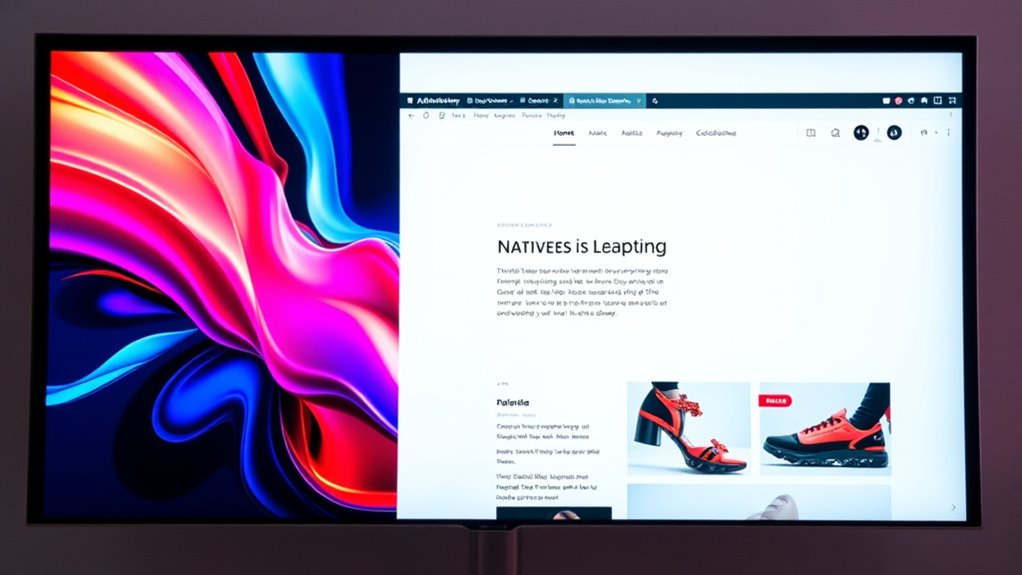To maximize RPM on low-intent traffic, focus on using native ads that blend seamlessly with content, encouraging natural engagement without disrupting the user experience. Place native ads within relevant articles or social feeds, and position display ads in high-visibility areas like headers or sidebars for immediate attention. Combining strategic placement with ongoing testing of creatives and messaging helps improve results. For more tips on balancing these ad formats effectively, keep exploring how you can optimize your ad strategy.
Key Takeaways
- Use native ads within relevant content to boost engagement and RPM on low‑intent traffic.
- Position display ads in high-visibility areas like headers or sidebars for immediate impact.
- Test different creatives, placements, and messaging to optimize ad performance and user interaction.
- Align native ad messaging with surrounding content to create a seamless, less disruptive user experience.
- Continuously analyze user behavior with AI tools to refine strategies and maximize revenue.

When choosing between display ads and native ads, understanding their differences can substantially impact your marketing strategy. On low‑intent traffic, where visitors aren’t actively searching for products or services, selecting the right ad type and deployment approach becomes even more vital. You need to craft ad placement strategies that naturally blend with the content while still capturing attention. Native ads excel here because they seamlessly integrate with the user’s browsing experience, making them less intrusive and more likely to generate engagement. Conversely, display ads tend to be more prominent and eye-catching but risk being ignored or blocked, especially in crowded digital spaces. By understanding the strengths and weaknesses of each, you can optimize your ad placements to maximize RPM and user engagement.
Native ads blend seamlessly with content, boosting engagement on low‑intent traffic while display ads demand strategic placement to stand out.
To effectively engage users on low‑intent pages, you should tailor your ad placement strategies to fit the context. Native ads work best when placed within relevant content, such as articles, videos, or social feeds, where they can complement the user’s interests without disrupting their experience. This subtle approach encourages users to interact naturally, increasing click-through rates and conversions. In contrast, display ads often perform better when strategically positioned in high-visibility areas—like header banners or sidebar placements—where they can attract attention without overwhelming the content. Testing different placements helps identify where your audience is most receptive, ensuring you’re maximizing monetization potential.
User engagement techniques also differ between the two ad formats. Native ads leverage storytelling and contextual relevance to forge authentic connections with your audience. When users see content that resonates with their interests, they’re more inclined to click, share, or explore further. To boost engagement, consider aligning your native ad messaging with the surrounding content and employing compelling visuals and calls-to-action. Display ads, on the other hand, rely on bold visuals and concise messaging to grab attention quickly. Using contrasting colors, animations, or dynamic elements can make display ads stand out, but be careful not to overwhelm the user or diminish the overall site experience. Both formats benefit from A/B testing different creatives, placements, and messaging styles to refine your approach continually.
Ultimately, the key to maximizing RPM on low‑intent traffic lies in understanding how each ad type interacts with your audience. Native ads foster subtle engagement through relevance and storytelling, while display ads can create immediate impact with eye-catching visuals. Incorporating AI-driven analytics can help optimize ad performance by providing insights into user behavior and engagement patterns. By integrating strategic ad placement strategies and user engagement techniques tailored to each format, you can improve your ad performance, increase revenue, and provide a less disruptive experience for your visitors. Remember, the goal isn’t just to place ads but to make them feel like a natural part of the user journey, encouraging interaction without pushing users away.
Frequently Asked Questions
How Do Ad Formats Impact User Engagement Differently?
Ad formats considerably impact user engagement by influencing visual engagement and content relevance. Native ads blend seamlessly with content, making users more likely to interact because they feel natural and relevant. In contrast, display ads often stand out but may cause banner blindness, reducing engagement. You should choose formats that enhance visual engagement and maintain content relevance to keep users interested and improve overall interaction rates.
What Are the Best Practices for Ad Placement?
You should focus on ad placement strategies that prioritize user experience, avoiding intrusive locations. Place ads near content that naturally draws attention but doesn’t disrupt reading flow, like within or at the end of articles. Test different positions to find what works best with your audience, ensuring ads complement your site’s layout. Remember, a seamless user experience encourages engagement and boosts RPM, especially on low‑intent traffic.
How Can I Measure RPM Effectively?
Oh, measuring RPM must be like trying to catch a unicorn, right? But really, just focus on ad viewability and click-through rate. Track your impressions and earnings to see how much revenue you generate per thousand views. Use analytics tools to monitor these metrics regularly. If your viewability drops or CTR stalls, it’s time to tweak your ad placements or creatives. Simple, yet often overlooked—like your favorite sock.
Which Ad Type Is More Sustainable Long-Term?
You’re wondering which ad type offers better long-term sustainability for your ad revenue. Native ads tend to blend seamlessly with content, boosting user engagement and maintaining ad sustainability over time. They adapt well to changing audience preferences and platform updates. Display ads can generate quick revenue but might become less effective as user fatigue sets in. Focusing on native ads can help you build a more consistent and sustainable ad revenue stream.
How Do Ad Types Influence Brand Perception?
When it comes to how ad types influence brand perception, you gotta remember that first impressions count. Native ads often boost brand recognition because they blend seamlessly with content, making your brand seem more credible. Display ads might stand out more but can sometimes hurt ad credibility if seen as intrusive. Ultimately, choosing the right ad type affects how your audience perceives your brand, shaping long-term loyalty.
Conclusion
So, next time you’re stuck choosing between display and native ads, remember: maximizing RPM on low-intent traffic is all about pretending your ads are just part of the scenery. After all, who needs genuine engagement when you can just blend in and hope some unsuspecting click happens? Keep up the illusion, and maybe someday, you’ll master the art of making pennies look like dollars—because, really, isn’t that what everyone’s online dream is about?









